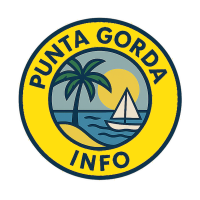The Story of Punta Gorda
A journey through time, culture, and community on Florida’s Gulf Coast
The Story of Punta Gorda
Punta Gorda, a picturesque waterfront town in Southwest Florida, is a place where history and culture intersect beautifully. Located where the Peace River meets Charlotte Harbor, this Victorian-era town has preserved its historic charm while embracing modern artistic and cultural amenities. From its visionary beginnings with waterfront parks to its vibrant mural program and thriving arts scene, Punta Gorda tells a compelling story of resilience, creativity, and pride in place.
Founding & Early Growth
Punta Gorda was officially founded in 1884 when Isaac Trabue, a wealthy former Confederate colonel, commissioned surveyor Kelly Harvey to subdivide 30 acres of land along Charlotte Harbor. Originally named “Trabue,” the name was quickly changed by local surveyors to the more fitting Punta Gorda, Spanish for “fat point,” referencing the town’s location on a peninsula.
The city was incorporated in 1887, shortly after Henry Plant extended his railroad to the area. Though Trabue and Plant reportedly disliked each other, their reluctant collaboration brought tourism and economic growth. Wealthy investors, including Cornelius Vanderbilt, were drawn to the newly constructed Hotel Punta Gorda. The city thrived on seasonal tourism, agriculture, and fishing.
Before European development, the region was home to Native American peoples and was later explored by Ponce de Leon in the 1500s. The post–World War II era brought another population boom, especially with the development of canal communities like Punta Gorda Isles and Burnt Store Isles, attracting retirees and boating enthusiasts.
Historic Districts & Landmarks
Punta Gorda features one of the most impressive historic districts in Florida. The city has 125 structures listed on the National Register of Historic Places and over 230 listings on the Local Historic Register. Iconic structures include the A.C. Freeman House and other well-preserved homes from the late 19th and early 20th centuries.
The Historic Preservation Advisory Board (HPAB) conducted an extensive survey in 2017–2018 to update and protect historic sites. Their work ensures these properties maintain their character while accommodating modern needs. New land development regulations reflect this commitment to preservation.
Museums & Cultural Institutions
Punta Gorda is home to several cultural centers that preserve and celebrate the area’s heritage:
Military Heritage Museum – This 17,000-square-foot facility near Fishermen’s Village chronicles the history of the U.S. military through artifacts, performances, and interactive exhibits. Veterans often serve as guides.
Punta Gorda History Center – With a core collection known as the Vernon Peeples Collection, the center houses over 2,500 books, 20,000 historical postcards, 200+ antique maps, 1,500 photographs, and rare business records.
Punta Gorda History Park – This open-air museum features several restored historic homes and gardens, giving visitors a hands-on experience of the town’s early lifestyle.
Notable Figures & Legendary Stories
Punta Gorda’s past is full of captivating characters and lore:
George Brown was a Black shipbuilder and landowner known as Florida’s first equal opportunity employer.
Albert W. Gilchrist helped shape the town’s fishing and rail industries and later became Governor of Florida.
Robert Meacham, an African American postmaster, served in a key leadership role during Reconstruction.
One of Punta Gorda’s most enduring legends is the ghost of Mary Leah Sandlin, a 14-year-old girl who died tragically in 1909. Her spirit is said to haunt her former family home, with tales of phantom footsteps and mysterious laundry activity.
President Theodore Roosevelt visited in 1917, attempting to catch a record manta ray—he landed a 16-footer but fell short of the world record.
Public Art & Murals
Punta Gorda is an open-air gallery thanks to the work of the Punta Gorda Historic Mural Society. Over 30 murals across town depict stories of the city’s heritage, turning everyday spaces into windows into the past.
Notable murals include:
“End of the Line” – showing the arrival of the railroad and the rivalry between Trabue and Plant.
“Cattle Drive Down Marion Avenue” – a tribute to Florida’s cattlemen.
“The Life & Times of George Brown” – honoring one of Punta Gorda’s most impactful figures.
In 2025, the Society released a book titled Painting the Town, celebrating 30 years of mural-making and storytelling.
Historic Tours
The city offers several immersive tours that share Punta Gorda’s stories:
Haunts & History Tour – A 1.5-hour walking tour mixing historical facts with spooky local lore.
Walking Tour of the Murals – Explore murals with QR-code access to stories and history.
Self-Guided History Walks – Maps and resources available at the History Center.
Arts, Events & Creative Culture
Punta Gorda’s creative spirit thrives through local galleries, festivals, and performance spaces:
Visual Arts Center – Features exhibitions, art classes, and community events.
Sea Grape Artists Gallery – A cooperative showcasing local works from painting to ceramics.
Peace River Botanical & Sculpture Gardens – Combines art and nature with stunning sculptures amid lush landscapes.
The annual Seafood & Music Festival at Laishley Park draws visitors with fresh cuisine, live music, and a vibrant vendor market.
Punta Gorda is more than a scenic harbor town—it’s a living museum of Florida’s coastal legacy. The city’s rich blend of history, art, and culture is deeply woven into every mural, historic home, public park, and waterfront path. Whether you’re uncovering hidden stories on a walking tour or taking in the sights along the Harborwalk, Punta Gorda offers a meaningful connection to the past—one that continues to inspire and welcome future generations.
